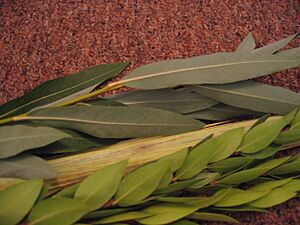Aravah (Sukkot) facts for kids
The Aravah (pronounced ah-rah-VAH) is a leafy branch from a willow tree. It is one of four special plants used during the Jewish holiday of Sukkot. These four plants are called the Four Species (or arba'ah minim in Hebrew). The other three are the lulav (a palm branch), the hadass (a myrtle branch), and the etrog (a type of citrus fruit).
The aravah is also used in a separate ceremony on Hoshana Rabbah, which is the last day of Sukkot. During this ceremony, five aravah branches are gently beaten against the ground.
Contents
What is the Aravah?
The aravah tree usually grows near rivers. In Israel, you can even find it growing wild in many backyards. Its branches grow long and have many narrow leaves.
Since this tree needs a lot of water, the branches dry out quickly after being picked. To keep them fresh for the Sukkot holiday, people often store them in the refrigerator. They might also wrap them in a damp towel.
Using the Aravah on Sukkot
During the seven days of Sukkot (except on Shabbat), two aravah branches are tied together. They are bundled with the lulav and hadass branches. This bundle is often just called "the lulav."
Together with the etrog, these Four Species are waved in all directions. People wave them to the front, back, left, right, up, and down. This waving shows that God is in charge of everything in the world. It also acts as a prayer for enough rain for all the plants in the coming year.
The Hoshana Rabbah Ceremony
On Hoshana Rabbah, the last day of Sukkot, there is a special ceremony. After the morning prayers in the synagogue, each person takes a separate bundle of five aravah branches.
People read special verses during this ceremony. These verses often express hope for good things to come. After reading the verses, the bundle of aravah branches is gently beaten against the ground. This is done until some of the leaves fall off.
After the ceremony, the aravot branches can be thrown away. Sometimes, people save them to use for burning Chametz (leavened bread) before Passover. Other times, they are placed in water to try and grow new aravah trees.
Aravah in the Ancient Temple
Long ago, during the time of the Temple in Jerusalem, there was a special aravah ceremony. Willow branches were gathered from a place near Jerusalem called Motsa. These branches were then placed upright around the sides of the Altar in the Temple. Their tops were bent over the top of the Altar. This was done every day of Sukkot.
During this ceremony, a shofar (a ram's horn trumpet) was blown. Worshippers would walk around in a procession. They would recite special prayers, similar to what is done today on Sukkot. Musical instruments were also played, except on Shabbat.
The ancient texts tell us that after the Aravah ceremony on Hoshana Rabbah, children would throw away their lulavim and eat their etrogim.


